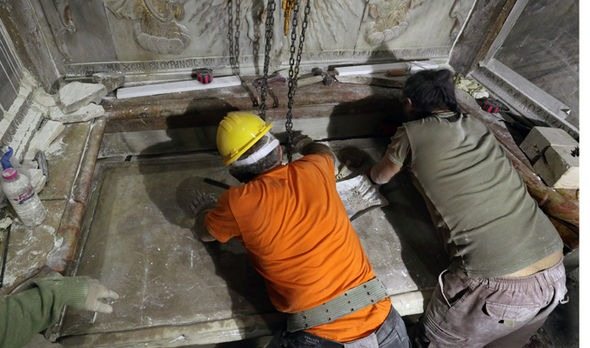Israel has some of the most important Christian holy sites in the world. The Church of the Holy Sepulcher is the most important of these. It is believed to be the tomb of Jesus. After hundreds of years of water damage, scientists finally started to renovate the tomb in October 2016. Under a marble slab that had been removed for the first time in hundreds of years, a discovery was made that no one had ever seen before.
The first church was inaugurated in 326 CE by the famous Roman Emperor Constantine the Great. It was built on the grounds where the divine mysteries of Christ’s life and resurrection were kept.
The Franciscan friars restored the church after the bell tower collapsed in 1545.
In 1555, Franciscan monks took a big step to protect the tomb’s sacredness by sealing its entrance.
The delicate process of restoring the Church of the Holy Sepulcher is based on many years of tradition and responsibility.
Each custodian, bound by faith and tradition, was committed to preserving the church’s sanctity. This led to many discussions and disagreements that often stopped progress.
In 1947, the Ottoman edicule was covered in iron scaffolding during British colonial rule to prevent its collapse.
Almost 70 years later, in 2016, a big project was started to protect the holy site of Jesus’ tomb.
The discovery of two crucifixion nails – one found near Jerusalem in 1968 and the other in Italy in 2018 – gave us a brief look at the real things used by the Romans, showing that there is not much evidence from the time of Jesus.
In the 1970s, researchers dug up some old ruins and discovered that the Holy Sepulcher had changed a lot over time.
It became clear that the building was not just a symbol of early Christianity, but a deliberate attempt to hide the remains of a pre-existing major religion that had power over the holy site.
The layers of time were peeled back to reveal a tapestry of religious transitions and imperial interventions. This showed the intricate interplay between faith, power, and the reshaping of sacred landscapes.
In the 20th century, the Church of the Holy Sepulchre was dug up and explored, revealing many ancient artefacts.
The team worked really hard for 60 hours straight in the Church of the Holy Sepulchre from 25 to 26 October 2016. They carefully moved the big stone slab many times.
When the team finally lifted the heavy marble slab, everyone was silent.
In 2016, the team used optically stimulated luminescence (OSL) to work out when the material was last exposed to light.
Among the things they found were bits of old crosses. These bits of wood, worn down by time, told stories of people’s strong beliefs and the journeys they had made in the past. Among the religious objects were also pieces of pottery. These delicate objects showed what the people who made them were like and made you think about how they used to live and worship.
Among the artefacts from the past, small coins from different historical periods shone like signs of past transactions. These coins showed us the economic activity at the site, which was a part of the lively religious activity there. Each discovery was carefully recorded and studied, and these records were vital in understanding the mysterious past of the tomb. They showed us what people believed, what they did, and how people acted, which tells us about the spiritual history of the ancient room.

 Discuss
More news
Discuss
More news


